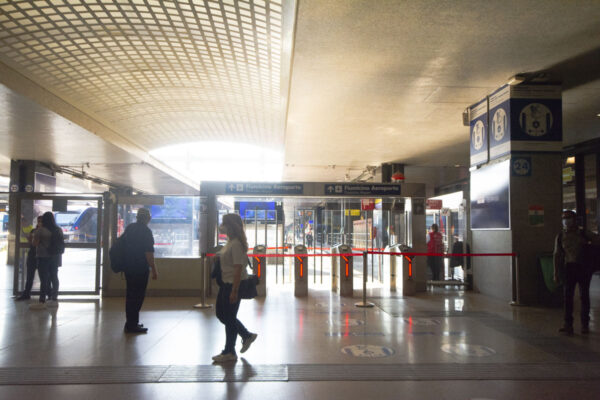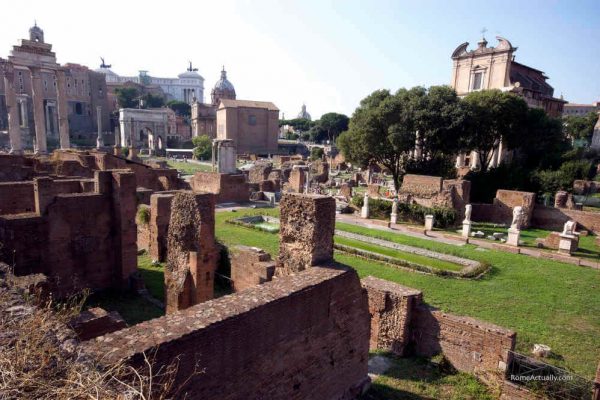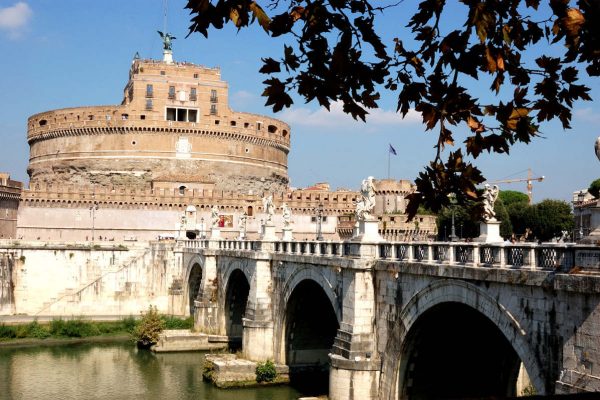One of the big stars of Rome’s art and architecture heritage, the all-around artist Gian Lorenzo Bernini has left his stunning traces all over the city. The genius that much contributed to shaping the Italian Baroque, chasing the works of Bernini in Rome you will find beautiful squares, elaborate fountains, sculptures, and paintings.
Whether you are staying four days in Rome or only one day, chances are, you are going to stumble on one or more of Bernini’s masterpieces. You will find Bernini’s works in Rome’s museums, notable palaces, and churches, adding tremendous value to your trip to the Italian capital.
Bernini and Rome: A Deep, Long-Lasting Love
Even though he was born in Naples, Bernini’s city has always been Rome. He moved here with his family in 1606 when he was only 8 years old because his father Pietro was commissioned to work on a chapel in Santa Maria Maggiore Basilica. Bernini lived most of his life in Rome and only occasionally left his beloved city mainly for working purposes such as the stint of a few months in Paris for King Louis XIV and commissions in the neighboring towns of Castel Gandolfo, Tivoli, and Civitavecchia.
In his article “The Genius of Bernini” for The Burlington Magazine, in 1915 Martin S. Briggs reported: “Michelangelo wandered from Rome to Florence and from Florence again to Rome, dividing his affections between the two cities. For Bernini there could be only one Rome. ‘You are made for Rome’, said Pope Urban VIII to him, ‘and Rome for you'”.
He was still a child when Bernini’s talent became one of the favorite topics in the Roman courts and papal corridors, catching the attention of powerful patrons within the clergy, including Popes such as Paul V and cardinals such as Scipione Borghese and Maffeo Barberini, the future Pope Urban VIII and strong supporter of Bernini’s art and work.
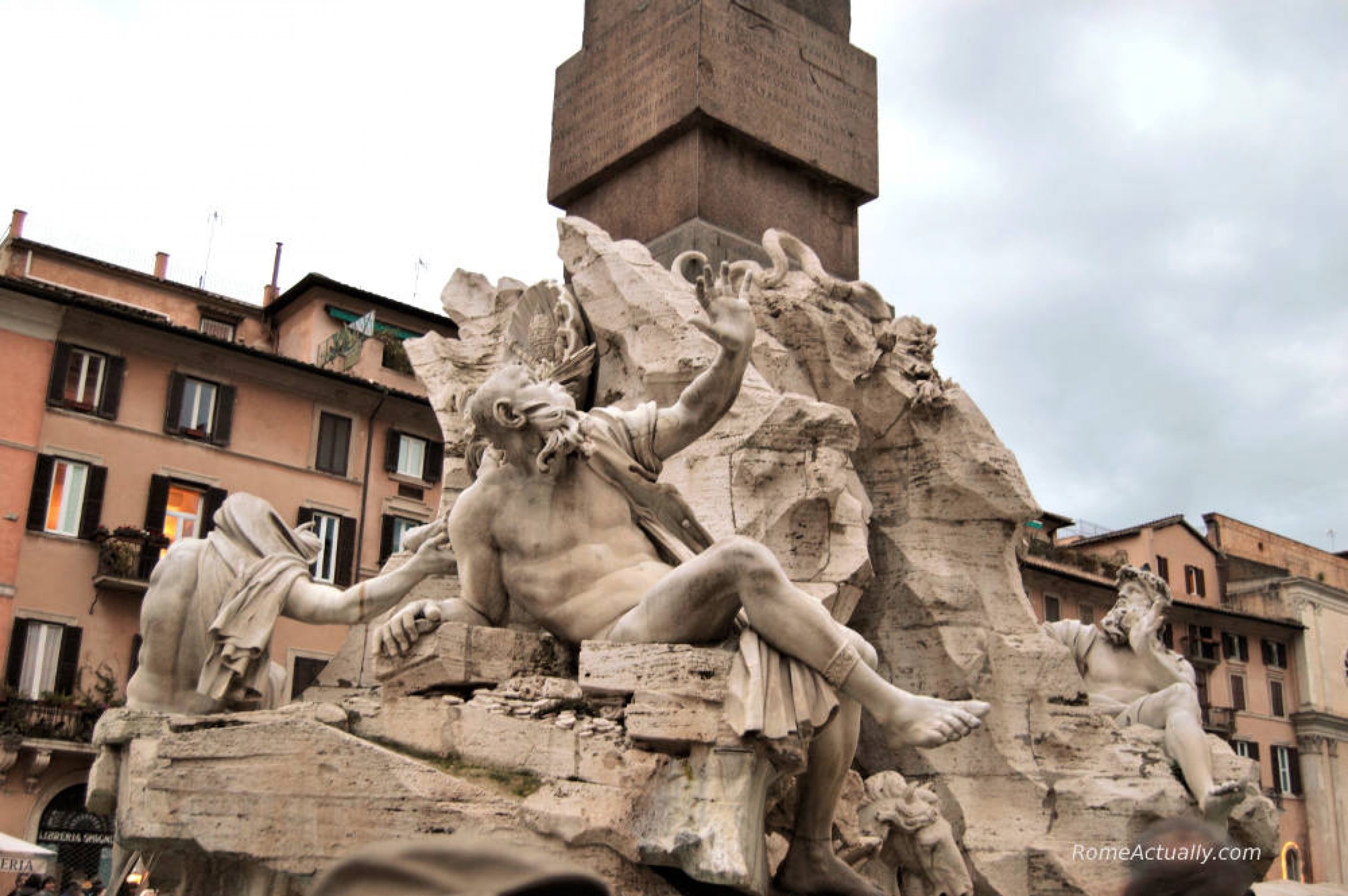
Diplomatic and easy to deal with, it’s also thanks to his affable attitude that Bernini managed to score more commissions than his peer and always rival Borromini, another genius of the Italian Baroque. So while Borromini was quite cranky and very little tactful, Bernini perfectly placed himself in the important circles of the society in good relations with both the clergy and Rome’s notable families that sooner or later all managed to secure a pope in their genealogy tree. Bernini was a man of his time in full, but as many of his biographers point out, he did cherish his freedom and always managed to keep his art “his” rather than abiding by the Roman Catholic Church in toto.
In our Bernini-theme itinerary in Rome, we will discover a beguiling mix of sacred and secular art and architecture, stunning fountains, gates, and piazzas. Brace yourself because we are ready to go.
Where to See Bernini in Rome
Architectural masterpieces of Bernini in Rome
St. Peter’s Square, Vatican City
One of Rome’s most beautiful piazzas is in fact one of the most famous works by Gian Lorenzo Bernini located in the Vatican City. From wherever you look at it, be it from a side of the colonnade, from the facing Via della Conciliazione or from the top of the dome, St. Peter’s Square is spectacular.
Elliptical in shape and framed by the colonnade of 284 pillars commissioned to Bernini in Rome by Pope Alessandro VII Chigi, building this square took 11 years, a huge team of workers, and tonnes of marble from Tivoli.

What you will quickly perceive in St. Peter’s Square is the optical illusion and perspective Bernini perfectly achieved. This was especially striking before the building of Via della Conciliazione by Benito Mussolini when in its place there was the charming cluster of narrow alleys and medieval buildings known as Spina di Borgo.
Crossing the square, you can see the columns getting far and then closer again conveying a continuous sense of movement. From the center of the square, where stands one of Rome’s tallest ancient obelisks, on both sides, look for a marble circle, step on it and look at the colonnade: it will appear as if made of a single row.
Where: St. Peter’s Square, Vatican City.
When: Alway open.
The Baldachin of Saint Peter, St. Peter’s Basilica
Built between 1624 and 1633 under the rule of Pope Urban VIII from the powerful Barberini clan, this was Bernini’s first important work and probably where the long-standing and legendary rivalry between Bernini and Borromini originated.
Piling up centuries of protection the tomb of Saint Peter, as soon as Urban VIII Barberini was elected to lead the Christian Kingdom, he understood there was the need for a ciborium worthy of the importance of the place and that there was no better artist than Gian Lorenzo Bernini to make this happen.

Like always, the artist didn’t fail to impress and the result became known as the most important bronze sculpture of the Italian Baroque. A 28-meter-tall baldachin located in the heart of Saint Peter’s Basilica right under Michelangelo’s dome is one of the main and complex masterpieces produced by a rich team of artists led by Bernini that included also Francesco Borromini.
The beautiful pillars, the polychrome marbles of the base, the winding top probably designed by Borromini, and the angels holding St. Peter’s keys and the papal crown concoct in creating an opulent yet harmonic baldachin that despite its size, perfectly blends inside the basilica.
Where: St. Peter’s Square.
When: Every day 7 am-6.30 pm (in summer until 7 pm).
Don’t miss our extensive guide to the masterpieces of Borromini in Rome.
Palazzo Barberini
Even though Palazzo Barberini is not the most famous work of Bernini in Rome, it’s a pivotal one because it was one of his first important commissions. Like it or not, despite their mutual animosity, the peer genius artists Bernini and Borromini had to work side by side here, too.
As one of the leading architects and a favorite of the Barberini clan, Bernini replaced Carlo Maderno after his death in 1629 in overseeing the construction works. Here, visitors will find two masterpieces of Bernini in Rome: one of the two staircases (the square one, while the helicoidal is a project by his peer Borromini) and the bust of Pope Urban VIII made between 1632 and 1633.

The building of the square staircase had been a challenge since its inception. Aimed at the northern wing of the original Sforza palace, to build this large staircase Bernini to connect the main entrance in the current Via Barberini to the existent staircase leading to the garden and then the upper floors, had to consider a complex multi-level structure. Needless to say, Bernini overcame the challenges and the result is a monumental masterpiece that made the client happy.
The bust of Pope Urban VIII shows Bernini’s painstaking attention to detail that made it possible to give life to a piece of marble. The lips that seem like they are about to say something, a half-sealed button, perfectly carved eyes concoct to make this a true masterpiece of Bernini you can see in Rome.
Where: Via delle Quattro Fontane 13.
When: Every day 10 am-6 pm. Closed on Monday.
Make sure you read our selection of the most fascinating buildings in Rome.
Chiesa di Sant’Andrea al Quirinale
Commissioned by Pope Alexander VII and cardinal Camillo Pamphilj who funded it, the church devoted to Sant’Andrea e San Francesco Saverio was built on top of an existing building between 1658 and 1678. This is the masterpiece Bernini himself considered his best thanks to the perfect balance between the different forms of art such as architecture, painting, and sculpture he managed to achieve.

Before reaching the elegant facade displaying the huge crest of the Pamphilj cardinal you will go through a semi-round staircase and an entrance supported by two pillars. One of the main features that make the church famous is its oval shape and the interior is rich in artwork, including the precious main chapel designed by Bernini himself and decorated with lapis lazuli stones and golden bronze.
Where: Via del Quirinale 30.
When: Tuesday-Sunday 9 am-12 pm and 3-6 pm. Closed on Monday.
Porta del Popolo (Ancient Porta Flaminia)
The imposing gate to one of the world’s most spectacular access to the historic center bears the contribution of Bernini. Marking the boundaries between Piazza del Popolo and Piazzale Flaminio, Porta del Popolo is an ancient gate of the Aurelian Walls to the city. Its original name was Porta Flaminia because it was from here that the ancient consular Via Flaminia road starts.

After centuries of neglect, today’s appearance dates back to the 16th century when Pope Pius IV commissioned the restoration of the exterior of the gate to Michelangelo who passed the work to Nanni di Baccio Bigio.
In mid 17th century, Pope Alexander VII Chigi commissioned Bernini to work on the internal side of Porta del Popolo and the artist completed it with the inscription “FELICI FAVSTO Q[VE] INGRESSVI ANNO DOM[INI] MDCLV”, Latin for “a happy and favorable entrance, 1655 AD” in the occasion of the arrival in Rome of Christina of Sweden. On top of the gate is visible the crest of the Chigi family, a six-piece mountain with an 8-ray star on top.
Where: Piazza del Popolo
When: Always open.
Basilica di Santa Maria del Popolo
One of the most famous churches in Rome, also Santa Maria del Popolo Basilica, located on the left side of the namesake piazza when coming from Porta del Popolo gate, enshrines the works of our Gian Lorenzo Bernini.
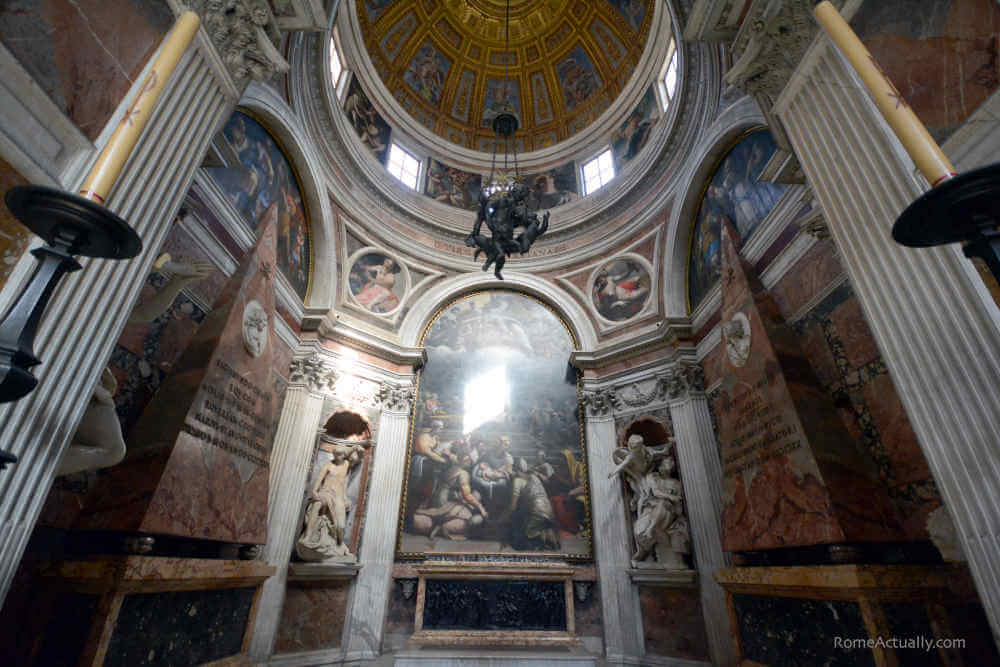
Upon the will of Pope Alexander VII Chigi, Bernini worked on the renovation and general decoration of the interior, bringing partial changes to its former Renaissance style. Under the same pontiff, between 1652 and 1656, he was in charge of completing the Chigi Chapel the construction of which began in 1513 by Raphael commissioned by banker and powerful Agostino Chigi.
Where: Piazza del Popolo
When: Every day 7.30 am-12.30 pm and 4-7 pm. Sunday and holidays until 1.30 pm in the morning and from 4.30 pm in the afternoon.
Palazzo Montecitorio
Currently the seat of Italy’s lower chamber of the Parliament, Palazzo Montecitorio was commissioned to Bernini by Pope Innocent X Pamphilj in 1653 to make it as the residence of the Ludovisi family, originally from Bologna that moved to Rome mid 16th century and that entered in the ranks of the Pamphilj family when Niccolò Ludovisi married Costanza Pamphilj, daughter of Donna Olimpia Maidalchini and niece of the Pope.

In 1655 the pope died and the works were halted, to start again around 30 years later under the rule of another pontiff, Innocent XII. Meanwhile, also Bernini had died in 1680 and the palace was commissioned to architect Carlo Fontana who brought some changes in adding the bell gable and two doors but leaving the convex facade. The palace was finally inaugurated in 1696 and became the seat of the Curia Pontificia, the papal court.
Where: Piazza di Monte Citorio.
When: Not possible to visit inside.
Palazzo Odescalchi-Balbi
Palazzo Chigi Odescalchi-Balbi is a noble palace in Rome’s city center. Built in Baroque style, its facade was designed by Bernini. Inside is Caravaggio’s work on wood “The Conversion of Saint Paul”, probably the model of the painting commissioned in 1600 by Tiberio Cerasi for his chapel that we can see in Santa Maria del Popolo Basilica. This one in the Palazzo Odescalchi-Balbi is one of the very few Caravaggio works belonging to a private collection.

The history of the palace is quite bumpy. Its construction began in the 15th century as the residence of the Benzoni family. In 1622 cardinal Ludovico Ludovisi bought it and commissioned a full renovation to Carlo Maderno. Later the Colonna clan acquired it and in the 17th century, the new owner became cardinal Fabio Chigi who put Bernini in charge of building a proper facade. In the 18th century, he commissioned the expansion of the building to architects Salvi and Vanvitelli, changing the initial Bernini design.
Where: Piazza SS. Apostoli 80
When: This is private property so not open to visits.
Sant’Agostino Basilica
Famous for hosting one of Caravaggio’s paintings in Rome, Sant’Agostino Basilica is the result of the work of many artists, including Bernini. In 1627, Bernini designed the main altar of the church and architect Orazio Turriani built it. The altar was inaugurated in 1628 when a Byzantine statue of the Virgin Mary with Child brought from Hagia Sophia in Constantinople was placed in the center.
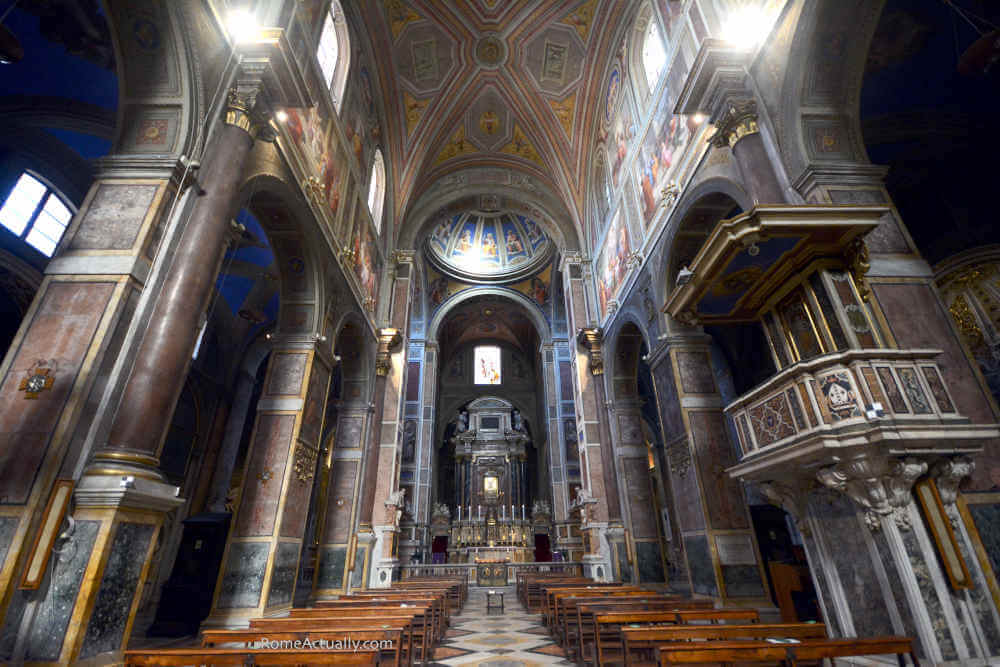
The second chapel of the left nave, too, is a design by Bernini commissioned by Angelo Pio, from whom the chapel takes its name, Cappella di Pio.
Where: Piazza Sant’Agostino
When: 7.15 am-12 pm and 4-7.30 pm.
Bernini Fountains in Rome
Piazza Navona, the Four Rivers Fountain
One of the most famous masterpieces of Bernini in Rome is the scenic Baroque Four Rivers Fountain in Piazza Navona. While it’s not the only Bernini fountain in Rome, it’s definitely a spectacular one.
When Pope Innocent X Pamphilj was busy sprucing up Piazza Navona, Bernini had briefly fallen out of grace due to a little technical incident involving the two bell towers of St. Peter’s Basilica facade that were destroyed before being even completed.
However, even though quite despondent and depressed, shrewd Bernini never lost his pride and sense of one-upmanship. Fortunately so, otherwise, right now we would see another fountain in the heart of one of Rome’s most beautiful squares, probably not as stunning as Bernini’s one.
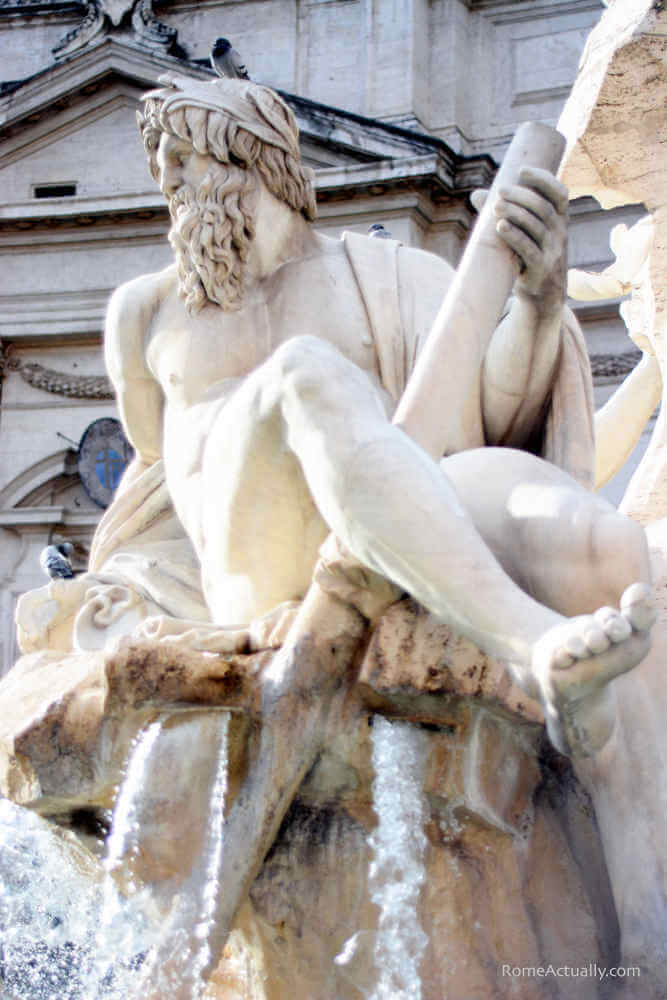

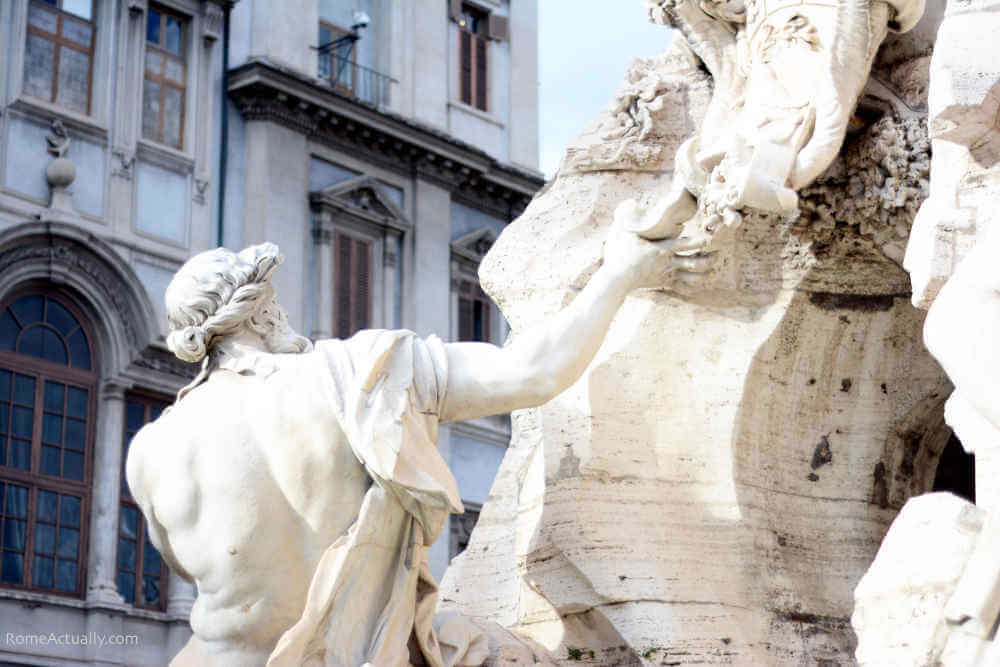
Now we know how the public competition announced by Pope Innocent X went. But how did Bernini win it? With a clever ruse: he offered the powerful Donna Olimpia, the pope’s sister-in-law and, according to rumors of the time, his mistress, a silver model of the fountain knowing the pope would have seen it because placed in the family palace in Piazza Navona.
The building of the stunning Four Rivers Fountain involved the labor of a large team of artists all managed and led by Bernini between 1648 and 1651. The oval-shaped basin supports rock-shaped travertine with a granite obelisk on top. From each corner of the rock start the four rivers of the Continents known at the time: Europe with the Danube, Africa with the Nile, Asia with the Ganges, Rio de la Plata for the Americas, each of them displaying wildlife and vegetation from their homeland.
Where: Piazza Navona.
When: Always open.
Fontana del Moro in Piazza Navona
On the southern edge of Piazza Navona, in front of Palazzo Pamphilj, today the seat of the Brazilian embassy, is one of the three monumental fountains of the square and one of the most famous fountains by Bernini in Rome. Known by the name Fountain of the Moor, its water was originally supplied by the Aqua Virgo aqueduct, the same that supplies other important fountains in Rome such as Trevi’s.
Originally designed by Giacomo della Porta and bearing dolphins, dragons, and tritons, in 1655, Bernini replaced the basin and designed the statue of the Moor that was placed in its center when commissioned by Pope Innocent X to renovate the fountain. The Moor holds a dolphin’s tail in his hands while the dolphin’s head pours water from between his legs.
Where: Piazza Navona.
When: Always open.
La Barcaccia in Piazza di Spagna
At the foot of the Spanish Steps is the famous fountain known under the name of La Barcaccia, the boat. Oval-shaped, this is the work of Pietro Bernini, the father of Gian Lorenzo, who is believed to have helped in the works. Built between 1626 and 1629, it was commissioned by the pope of the time, Urban VIII Barberini, and the water supplied by the ancient Aqua Virgo.

Loyal to its name, the fountain has the shape of a boat that gathers the water gushing out of two large suns placed in its interior one at the stern and one at the bow. The water overflowing from the boat’s flanks falls in the basin underneath. This fountain, too, shows the papal emblems complete with the bees, the crest of the Barberini family.
Where: Piazza di Spagna.
When: Always open.
Triton Fountain in Piazza Barberini
Fontana del Tritone in Piazza Barberini is another beautiful fountain of Bernini in Rome. Here, we see the Triton kneeling and with the head bending backward trying to blow in the large shell he’s holding in his hands and from which the water gushes out all over the marble complex. The shell that supports the triton is the fountain’s basin and underneath we can see four dolphins, the papal emblems and the crest with the bees, the symbol of the Barberini family.
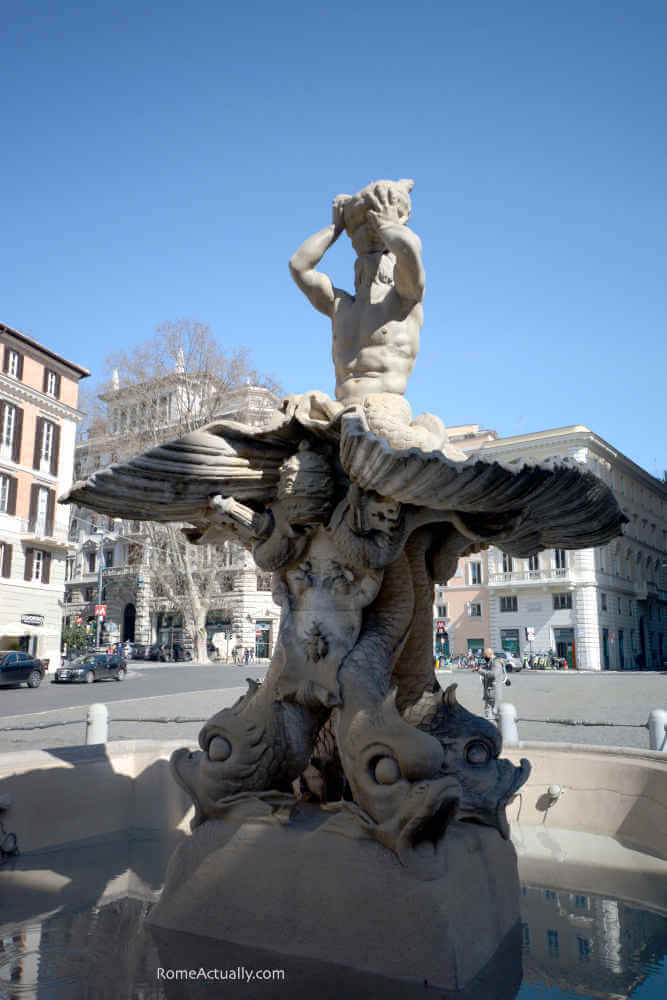
Fed by the Aqueduct Felix, this Triton Fountain is one of the masterpieces by Bernini in Rome created between 1642 and 1643. With his majestic palace dominating the view of Piazza Barberini, Pope Urban VIII commissioned the artist a fountain as another public ornament.
Where: Piazza Barberini.
When: Always open.
Fontana delle Api in Piazza Barberini
Commissioned by Pope Urban VIII Barberini in 1644, the small and beautiful Fontana delle Api is another of the masterpieces of Bernini in Rome. It’s located in Piazza Barberini at the beginning of Via Veneto near the church of Santa Maria della Concezione under which is the famous Capuchin Crypt that you can visit by booking one of the many underground tours of Rome. Originally, it was meant to be a public trough placed in Piazza Barberini on the corner with Via Sistina, near the monumental Triton Fountain.

With its water supplied by the Aqua Felix, this shell-shaped fountain bears the inscription in the name of the commissioner “Urbanus VIII Pontifex Maximus” as a reminder of the pope’s intervention in decorating the city and providing public service for its citizens. Even though it was supposed to be a public service building, Bernini couldn’t really help it and gave it a beautiful shape.
Where: Piazza Barberini.
When: Always open.
Bernini Sculptures in Rome
Ponte Sant’Angelo Bridge
One of the iconic bridges in Rome, Ponte Sant’Angelo connects the Hadrian Mausoleum with the Centro Storico. Apart from the imposing Castel Sant’Angelo standing at one end of the bridge, the scenic design that never fails to impress is the stunning succession of statues from the Baroque period. Even though the appearance is still Baroque, the bridge bears a long history from its creation between 130 and 134 by emperor Hadrian who wanted to connect his mausoleum to when it was restored in the 19th century.

Between 1668 and 1669 Bernini was put in charge to restore the bridge by Pope Clemens IX and on this occasion, he installed stone balustrades and iron gates as well as added ten more marble statues representing ten angels made by Bernini and his pupils. Whether you staying one or three days in Rome, chances are you are going to be around the area, so I totally suggest you walk across this stunning bridge and admire each and every detail on it. A perk? That’s the perfect postcard-like picture and one of the most romantic evening strolls in Rome.
Where: Ponte Sant’Angelo.
When: Always open.
Galleria Borghese
This important museum located in Villa Borghese is possibly one of the places that have the largest number of masterpieces by Bernini in Rome. While Bernini’s artwork preserved involves mainly sculptures, you can find also some of his paintings, including his two famous self-portraits.
Fans of Bernini will love walking the halls of this historical palace, but there is so much to see that whichever artist you come for, Galleria Borghese is an absolute must-see in Rome. Among the sculptures of Bernini you will see here are The Rape of Proserpina, the busts of Paul V and Scipione Borghese, The David, Aeneas, Anchises and Ascanius, and Apollo and Daphne.
Where: Piazzale Scipione Borghese 5.
When: Every day 9 am-7 pm. Closed on Monday.
Basilica di Sant’Andrea delle Fratte
Two of the ten statues aimed at the Ponte Sant’Angelo bridge were carved by Bernini himself and since they were considered too beautiful to be exposed to the weather and the crowds, they were replaced by copies and the original ones can be seen in Sant’Andrea delle Fratte Basilica near the main altar.
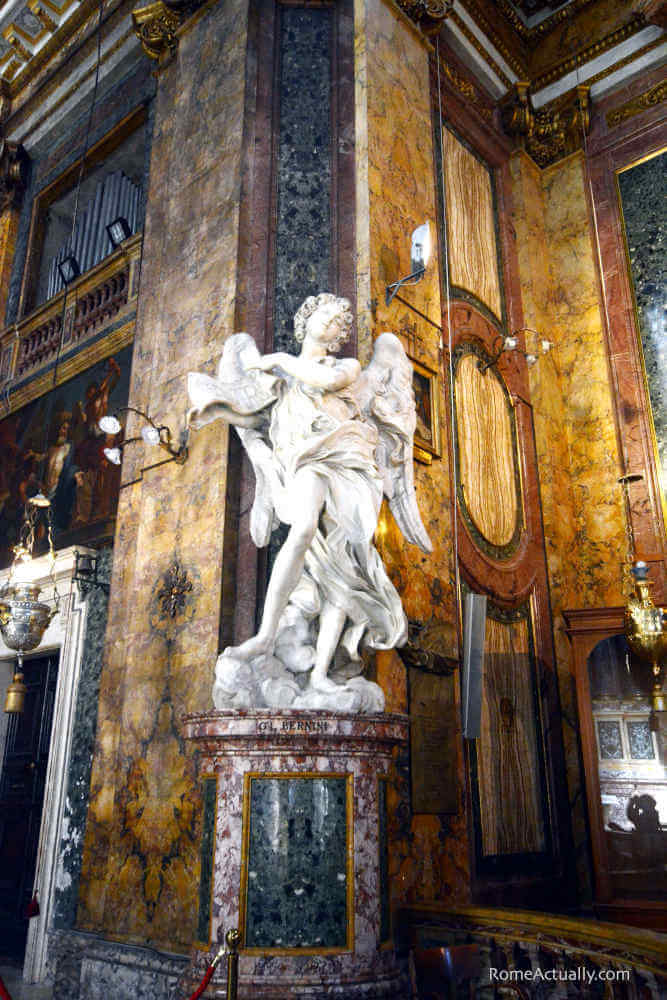

The church, located near Piazza di Spagna, was originaly founded in the 11th century but fully restored between 1653 and 1658 by Borromini. The facade, on the other hand, was completed only in the 19th century and looks very simple.
Where: Via di Sant’Andrea delle Fratte 1.
When: Every day 7.30 am-1 pm and 4-7.30 pm.
Monument to Maria Raggi in Basilica di Santa Maria Sopra Minerva
The funerary monument to Maria Raggi is one of the works of the young Bernini in Rome. The original architecture of this church dates to the 13th century probably by the same Dominican friars who designed Santa Maria Novella in Florence. The works went on for centuries, the same facade was completed only in 1453 upon orders of the Orsini Count.
Among the artists housed in Santa Maria Sopra Minerva Basilica, one of the lesser-known churches in Rome, are Michelangelo, Filippino Lippi, and our own Bernini. The monument was commissioned by her family and completed in 1647, a rare work of Bernini in Rome realized with black marble representing a soft drape wrapping the portrait of the dead woman supported by two angels, all in golden bronze.
Where: Piazza Minerva.
When: Every day 9 am-12 pm and 4-7 pm.
Elephant in Piazza della Minerva
In the square facing the Basilica di Santa Maria Sopra Minerva is one of the 13 ancient obelisks supported by a lovely sculpture representing an elephant. This elephant is one of the works of Bernini in Rome you can view in the open without needing to enter churches or museums.

When the obelisk was brought in Piazza della Minerva from its former location in the garden of the Dominican convent in the area where was the ancient temple devoted to Isis Egyptian goddess, many artists submitted their project for the building of the base. One of this was the Dominican friar Domenico Paglia, but his project was rejected and Pope Alexander VII asked Bernini, who submitted ten projects. Among these, the pope chose this elephant, probably because inspired by the book Hypnerotomachia Poliphili.
Where: Piazza della Minerva.
When: Always open.
Ecstasy of Saint Teresa of Avila Statue
One of the most striking and dramatic sculptures of Bernini in Rome is kept in the beautiful Baroque Chiesa di Santa Maria della Vittoria church designed by Carlo Maderno. Among all the artwork decorating the interior of the church, Bernini’s masterpiece is the main attraction.
The spectacular sculpture Estasi di Santa Teresa d’Avila is a complex in white marble and golden bronze where the saint lying on a cloud is placed in front of an angel that pierces her heart with an arrow. The sculpture appears brightened from above thanks to the rays of golden metal coming down on its back.
Where: Via XX Settembre 17
When: The church is temporarily closed because of damages on the roof.
Statues in Basilica di San Lorenzo in Lucina
Very close to the Parliament and Montecitorio Palace, the Basilica of San Lorenzo in Lucina is one of the oldest churches in Rome and takes its name probably from a wealthy Roman woman who allowed the Christian cult in her house when Christianity was still banned in Rome. Completely restored in the 12th century, inside it was redecorated in the 17th century and if you are still wondering where to see Bernini in Rome, the Fonseca chapel was one of his projects.
Bernini designed this chapel in 1670, when he was 72, and one of the highlights is the marble bust of the Portuguese doctor Gabriele Fonseca, the client who commissioned the work, appearing as if leaning out of the window.
Where: Piazza di San Lorenzo in Lucina 5.
When: Every day 8 am-7.30 pm.
WANT TO READ IT LATER? PIN IT TO YOUR BOARD!



